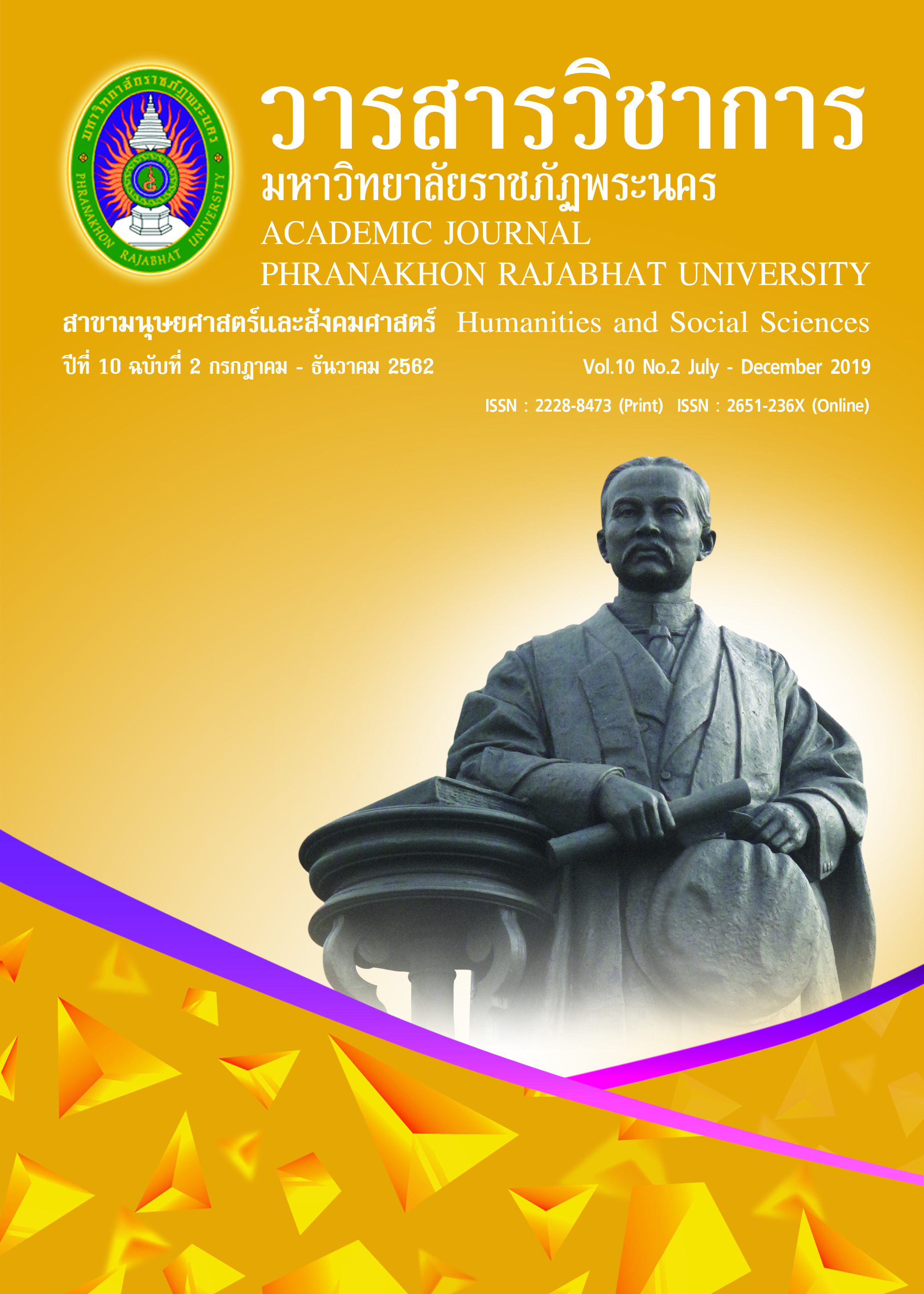การวิเคราะห์ความต้องการจำเป็นของการพัฒนาครู โรงเรียนเลิศหล้า สาขาถนนเกษตร-นวมินทร์ ตามแนวคิดคุณลักษณะของครูนวัตกร
คำสำคัญ:
การพัฒนาครู, ครูนวัตกร, สภาพปัจจุบัน, สภาพที่พึงประสงค, การวิเคราะห์ความต้องการจำเป็นบทคัดย่อ
การวิจัยครั้งนี้เป็นการวิจัยเชิงปริมาณ ซึ่งมีวัตถุประสงค์เพื่อศึกษาความต้องการจำเป็นของการพัฒนาครูโรงเรียนเลิศหล้า สาขาถนนเกษตร-นวมินทร์ ตามแนวคิดคุณลักษณะของครูนวัตกรผู้ให้ข้อมูลประกอบด้วย คณะผู้บริหารโรงเรียนเลิศหล้าจำนวน 20 คน และครูชาวไทยที่ทำหน้าที่ปฏิบัติการสอนในโรงเรียนเลิศหล้า ประจำปีการศึกษา 2561 จำนวน 84 คน รวมทั้งหมด 104 คน เครื่องมือที่ใช้ในการวิจัย คือ แบบสอบถามสภาพปัจจุบันและสภาพพึงประสงค์ของการพัฒนาครูโรงเรียนเลิศหล้า สาขาถนนเกษตร-นวมินทร์ ตามแนวคิดคุณลักษณะของครูนวัตกร วิเคราะห์ข้อมูลโดยใช้การแจกแจงความถี่ การหาค่าร้อยละ การหาค่าเฉลี่ย ส่วนเบี่ยงมาตรฐาน และการจัดลำดับความสำคัญของความต้องการจำเป็นผลการวิจัยเกี่ยวกับสภาพปัจจุบันและสภาพพึงประสงค์ของคุณลักษณะของครูนวัตกรทั้ง 6 ด้านในมิติภาพรวม พบว่า สภาพปัจจุบันของคุณลักษณะครูโรงเรียนเลิศหล้า สาขาถนนเกษตร-นวมินทร์อยู่ในระดับปานกลาง เมื่อพิจารณาเป็นรายด้าน พบว่า คุณลักษณะด้านทักษะการสังเกต ความกล้าเสี่ยง และทักษะการทดลอง ( = 3.09) มีค่าเฉลี่ยสูงสุด รองลงมา คือ ทักษะการสร้างเครือข่าย ( = 3.00)และต่ำที่สุด คือ ความคิดสร้างสรรค์ ( = 2.95)เมื่อพิจารณาความต้องการจำเป็นของการพัฒนาครูโรงเรียนเลิศหล้า สาขาถนนเกษตร-นวมินทร์ตามแนวคิดคุณลักษณะของครูนวัตกร พบว่า มีค่าความต้องการจำเป็นของด้านย่อยสูงสุดลำดับ 1คือ คุณลักษณะด้านความคิดสร้างสรรค์ (PNI = 0.61) อันดับ 2 คือ คุณลักษณะด้านทักษะการตั้งคำถาม (PNI = 0.60) อันดับ 3 คือ คุณลักษณะด้านทักษะการสร้างเครือข่าย (PNI = 0.57) อันดับ 4คือ คุณลักษณะด้านความกล้าเสี่ยง และคุณลักษณะด้านทักษะการทดลอง (PNI = 0.54) และอันดับ 5 คือคุณลักษณะด้านทักษะการสังเกต (PNI = 0.53)
เอกสารอ้างอิง
Bass, B.M. & Avolio, B.J. (1990). Transformational leadership development. California : Consulting Psychologists Press.
Boonyam, T. (2011). The Multi-Level Causal Factors Influencing Individual and Group Innovative Behavior for Marking Product Innovations in Thai Private Companies (Doctoral dissertation). Bangkok: Srinakharinwirot University. (in Thai)
Brochure Lertlah School Division. (2017).The Best in English Program Schools and Leader in International Program Schools 25 th Anniversary.
Chaemchoy, S. (2012). Concept of innovation for school management in the 21st century. The Journal of Education Naresuan University. 14(2), 117-128. (in Thai)
Chaemchoy, S. (2015) Technology leadership: Bringing technology to classrooms and schools in the Century 21. The Journal of Education Naresuan University. 16(4), 216-224. (in Thai)
Couros, G. (2014). 8 Characteristics of the “Innovator’s Mindset”. Retrieved from : http:// georgecouros.ca/blog/archives/4783.
Couros, G. (2014). The Innovator’s Mindset: Empower Learning, Unleash Talent, and Lead a Culture of Creativity.
Daft, R.L. (2008). The leadership experience. 4th ed. Mason, OH: Thomson south-western.
Meesuwan, W. (2017). Factors contributing to characteristics of teacher innovators in educational technology in Professional Pre-Service Teacher Schools of the Naresuan University Network. The Journal of Education Naresuan University. 19(3), 50-61. (in Thai)
Newquist, E. (2015). 7 Characteristics of Highly Successful Innovators. Retrieved from
http://www.innovationexcellence.com/blog/2015/03/13/7-characteristics-ofhighlysuccessful-innovators/
Prajan, O. & Chaemchoy, S. (2018). Administrative Model for Development Teacher’s Innovative Thinking Skills in the Basic Education School. The Journal of Education Far Eastern University. 12(1), 156-169. (in Thai)
Prajan, O. & Chaemchoy, S. (2018). The basic education school management for developing teacher’ s innovative thinking skills. Educational Management and Innovation Journal, Chulalongkorn University, 1(2), 53-68. (in Thai)
Rogers, E. M. (1983). Diffusion of innovation (3rd ed.). New York: Free Press.
Schrum, L and Levin, B.B, (2009). Leading 21st Century Schools: Harnessing Technology for Engagement and Achievement. California, United States of America.
Songkram, N. (2014). Innovation: The students to be innovators (2nd ed.). Bangkok: Chulalongkorn University Press. (in Thai)
Sutthawart, W., & Siriwong, P. (2015). Educational Innovator’s Potential Development Method. Veridian E-Journal, Silpakorn University, 9(1), 749-765. (in Thai)
Sutthawart, W., & Siriwong, P. (2015). The basic educational innovator in public sector: A study for grounded theory. Veridian E-Journal, Silpakorn University, 8(2), 281- 300. (in Thai)
Vanichvasin, P. (2009). A development model of innovative leadership competencies as part of informal education to enhance learning of selected leaders in Thailand. Doctoral Dissertation, Assumtion University
ดาวน์โหลด
เผยแพร่แล้ว
รูปแบบการอ้างอิง
ฉบับ
ประเภทบทความ
สัญญาอนุญาต
"บทความวิชาการในวารสารฉบับนี้ ถือเป็นความรับผิดชอบของผู้เขียนเท่านั้น"
สงวนลิขสิทธิ์ตามพระราชบัญญัติลิขสิทธิ์




